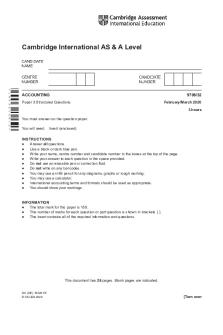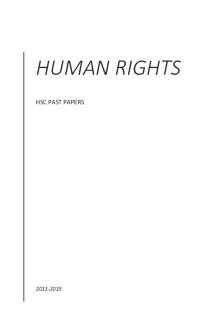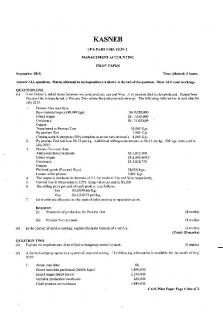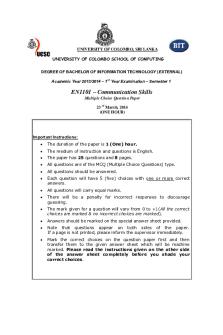ILW1501 FULL and Final Exam Notes including Past Papers PDF

| Title | ILW1501 FULL and Final Exam Notes including Past Papers |
|---|---|
| Author | Simoné Barnard |
| Course | Introdution to law |
| Institution | University of South Africa |
| Pages | 123 |
| File Size | 4.9 MB |
| File Type | |
| Total Downloads | 96 |
| Total Views | 133 |
Summary
Excellent Summary of Textbook. Includes past exam papers (questions and answers) and a 100% pass is guaranteed....
Description
a system of rights
Notes: ILW1501 a system of norms and rules
Study Unit 1: What is ‘law’ -
The relevance of law in daily life
The Law
Characteristics of the law: Is a set of rules / norms that governs human behaviour /conduct. should be obeyed by all of society & is binding is enforced by the state / state organs & When you do something wrong, you may be prosecuted & punished or be ordered to other party you have injured
compensate the
Identify events that have legal relevance, in other words, that has something to do with the law? Examples from the story→ examine legal norms to find out whether: Employment → retrenchment→ lawful / not lawful Payment of school fees → obligation Understand the part played by law in daily life? The law plays a very important role in daily life. parenting → legal norms relevant to parenting→ schooling / medical care Age of children → infant → steals → not liable for crime Two methods used to divide SA law into two main divisions: 1. SA law can be divided into the two main divisions of public law and private law
Public Law
Individual(s) State
The Law Private Law
Individual(s) Individual(s)
2. SA law can be divided into two main divisions of formal (procedural) and substantive (material) law.
Formal/Procedural Law
Deals with the procedures that must be followed in legal proceedings (rules, conduct, evidence)
Substantive/Material Law
Determines the content & meaning of the different legal rules
The Law
Explain the difference between legal norms and other norms? Some law→ norms (rules) → determine how one should interact and behave with another. This is what separate laws from those that are not norms. Therefore: A legal norm (law) binds all people. Other norms / other laws → law of chess→ bind only those who are playing. Explain the difference between formal justice and substantive justice? 1
Introduction to Law (ILW1501)
Justice: Equality before the law. SA Law makes two distinctions: Formal Justice Deals with the procedures that must be followed in legal proceedings (rules, conduct, evidence) Basic requirements that must be met for formal justice to be achieved: There must be explicit rules laid down to show how people must be treated in specific cases The rules must apply generally (all people in the group under the same circumstances) The rules must be applied impartially by a legal institution (judge may not be biased)
Substantive Justice Concerns the content of the rule and not the way in which it is applied. When there is formal justice that’s not really “real justice‟, substantive justice is raised. → Concerned with → content of rule → not how rule applied Here the content of the rule is looked at to determine whether it is just and fair. Examples: The apartheid rules were specific, applied to all and were applied impartially – however, the content of the rules were unjust and therefore justice was not served
Example of Formal Justice Martie van der Merwe is not promoted by New Africa University and she complains about the decision. The university provides her with a formal platform to raise her complaint. An impartial person hears the complaint and decides that the rules with regard to promotions within the university are clear and apply to all personnel equally. However, Martie feels that she was not promoted simply because she is a woman. Has justice been served in this case? It is clear that the requirements of formal justice have been met: The rules with regard to promotions within the New Africa University are explicit. These rules apply generally to all personnel. The rules are applied impartially because Martie’s complaint was heard by an impartial person. However, one still comes away with the feeling that the result might have been unjust. Therefore, we have to consider the issue of substantive justice. Example of Substantive Justice – In our scenario, the Mothibes and Van der Merwes are neighbours in present-day South Africa. However, they would not have been able to be neighbours in the 1950s under the apartheid regime, due to the implementation of the Group Areas Act. The application of the Group Areas Act included laws that specifically outlined that different race groups could only reside in defined geographical areas. Therefore, black and white people were not allowed to live in the same areas. The laws outlined in the Group Areas Act were specific, they applied generally to all persons and the rules were applied impartially (the rules were applied equally to all persons). Thus, we can see that the requirements of formal law were achieved. Consequently, formal justice was achieved, but it cannot be said that these rules served justice! We know that formal justice is not enough to make a legal system just. In this case, the content of the rules made them unjust as the content was unfair and discriminatory. Substantive justice was therefore not achieved! Group Areas Act 41 of 1950 The Group Areas Act was passed into law and became another fundamental policy of the apartheid regime, the aim of which was to cause segregation (separateness) amongst different racial groups. 2
Introduction to Law (ILW1501)
This Act formed the legal framework that allowed the government at the time to divide and establish particular neighbourhoods, solely on the basis of race.
This Act limited the property rights of all black people (Africans, Coloureds and Indians) as it allowed for the demolition of property and displacement of people into designated areas.
Under this Act, the different racial groups could only reside in legally defined geographical areas
Normative systems that rule/govern human behaviour: Aspects:
1. To whom do the rules apply? The Law Norms which the whole community regards as binding and must be obeyed Religion A set of rules in accordance with the people who practice that religion Individual morality Norms/standards that every individual sets for himself Community mores Norms of a whole community (collective morals) or group within that community
2. Sanction for noncompliance *Prosecution or punishment *Compensation to an injured party Every religion has its own sanction or punishment
3. Enforcer of sanction State organ Police Society Each separate religion
The sanction is personal and self-imposed Varying degrees of disapproval/rejection / discrimination by other members of the community
The individual The Community
Normative systems that governs human behaviour: Religion o Each religion has – code (a set of rules) to live by sanction (punishment) for those disobeying o There are many questions with regard to the relationship between religion and law. Although there are many differences and similarities, they might overlap, and cannot often be divided into separate categories. o There are different viewpoints in this regard: Religion and law should be mutually exclusive Religion and law should have the same content. o These views may be criticised as follow: There are many similarities & differences Differences: o Religion → 10 Commandments → not convey neighbour’s possessions o Law → this is not enforced o Religion → Adultery is a sin o Law → Adultery is not a crime Similarities: o Western legal tradition is influenced by Christian thought (canon law) o Canon law is the basis of: Modern Matrimonial law 3
Introduction to Law (ILW1501)
o o o
Regulation of sexual relationships Contracts may be concluded by mere agreement Content of law & religion same → offences in: Murder / Fraud / Theft / Perjury Both religion & law → studied by interpreting authoritative text: Ritual formalities & fixed procedure → NB role SA law favour Christian Religion: In criminal law Blasphemy → criminal offence & pertains to Christian God Christian holidays → Christmas / Good Friday
Individual morality (personal morality and ethics) – not enforced by law o They are personal, self-inflicted rules of each individual o Norms/standards of behaviour each person sets for himself Not to drink too much/ being honest/ not to lie o Can form part of religious convictions Not to tell lies (both individual & religious norms) o May go hand in hand with certain legal rules Honesty is violated when crimes of fraud are committed o Where the norm of individual morality coincide with a legal norm – only then will the law step in or intervene.
Community Mores o Collective morals of a whole community/ group in that community o Different from religion & morality Not private matters of a specific individual o Mores differ from each community – Unmarried couples living together (some may accept this and others may not) o Origin of some community mores may be found in religious convictions – gays are forbidden o Law & community mores may coincide Possession & sales of harmful drugs (disapproved by the community and it is a criminal offence) o Law & community mores may differ Law may not support these mores (there may not be laws good enough to prevent the distribution of child pornography) Community may feel that present censorship law are too strict & should be relaxed
Key concepts
Norm = a standard of human conduct/ a rule of human behaviour The law versus other laws: o Different things at different times o Law binds the community – private law o Other laws – binds people participating (law of cricket) Justice = equality before the law
4
Introduction to Law (ILW1501)
LEARNING UNIT 1 QUESTIONS AND ANSWERS Questions Mr and Mrs Clark have been married for the past ten years. They live in an exclusive but very conservative neighbourhood in Pretoria. Two years ago, Mr Clark, who is a well-known business man in the community, began an extra-marital relationship with his neighbour’s wife. When the neighbours found out about Mr Clark’s adultery a year later, they started to ignore him. Karel is under a lot of stress because of his retrenchment. This has caused him to start smoking. His family is most upset about this. Carmia says that he will get cancer. Martie argues that it is morally wrong to smoke. One of Karel’s friends tells him that smoking is a sin. One evening, Karel lights a cigarette in the non-smoking section of a city restaurant. When the manager asks him to put out the cigarette, Karel starts to argue with him. Karel argues that he does not think that it is morally wrong to smoke, but the manager replies that he is not interested in Karel’s “moral arguments”, because smoking in the non-smoking section of the restaurant is in contravention of the law (in this case, the Tobaccco Products Control Act 83 of 1993 21. Karel is so upset that he storms out without ordering any food. What are the merits of Karel’s argument and what are the merits of the management’s argument? Lizelle is an animal rights activist who regards the hunting of wildlife as unethical. She therefore frequently protests against the exploitation of animals at hunting and wildlife exhibitions. She also campaigns on her blog on the internet for the adoption of legislation to ban the hunting of caged lions in South Africa. When Lizelle becomes aware of caged lion hunting activities on a farm in the Northern Province, she writes to the Minister of Environmental Affairs. She demands the immediate shutting down of the farm and prosecution of the owners, since, in her view, the hunting of caged lions is in contravention of section 24 of the Constitution, which demands the protection of the environment.
Answers Normative system applicable = COMMUNITY MORES Sanction for non-compliance = DISAPPROVAL BY THE COMMUNITY
Karel’s moral view on smoking differs from the law’s policy on smoking. Even though Karel may not find it morally wrong to smoke, he is bound by the law prohibiting smoking in the non-smoking section of the restaurant. He may be prosecuted and probably fined. Did you also realise that a moral or religious norm may sometimes be the same as a legal norm? o Martie regards smoking as morally wrong o Karel’s friend believes smoking is a sin. In this case, their respective views on smoking coincide with the law’s policy on smoking.
Normative systems applicable: o Individual morality/ personal morality/ individual ethics individual morality, she regards hunting as unethical so she protests against it. This is her own personal view entailing to her. o The law/ legal rules/ legal norms there is an infringement of section 24 of the constitution which relates to the protection of the environment. To whom are the above mentioned normative system applicable? o Norms or standards that every individual sets for himself or herself o Norms which the whole community regards as binding and that must be obeyed Sanction for non-compliance with regards to the above: o The sanction for disobeying these rules are personal
and self-imposed Prosecution or punishment/ compensation to an injured party Who enforces the sanction for non-compliance? o Individual o State organ / the police / society o
Study Unit 2: Law and Rights
Understanding the difference between the concepts ‘law’ and ‘rights’
The law – system of norms/ rules & system of rights o Examples of rights: Right to car/book/against seller of car/ against all others who must respect my right to my car/ book etc. A legal subject is anyone who is subject to the norms of the law and who also may be the bearer of rights and duties. o Natural person o Juristic person such as a company A legal object may be anything that is of economic value to people (cost, usefulness, scarcity). o Costs a lot of money/useful/value to a particular person Other meaning of the word right: o Powers you can exercise in terms of your rights Right to use your cell phone and sell your house o Right to appear in court – not truly a right – ABILITY – CAPACITY WHY? There must be a legal subject and the right to an object of the right Legal relationship between legal subject and other legal subjects who must respect your right o Therefore the right to appear in court or the right to enter into a contract (no legal object/relationship) o Ability is given by the law in terms of a person’s status or legal standing and it is therefore called – CAPACITY (entering into a contract of sale/ right to appear in court) Law balance interest: o There are a number of things that a landowner may not do and which would be a nuisance/ cause harm to the neighbour’s property May not build up to the land boundary or dig a ditch at the boundary level as it could cause the neighbour’s land to sink down or cause excessive smoke If this occurs the law comes into operation meaning force to remove nuisance or compensate the other party Right & duty: o If a legal subject has a right; other legal subjects have a duty
What is a right? A right is how people relate to one another When you have a right to something – you are the holder of the right o Holder or legal subject – right to a legal object other legal subjects must respect your rights Every right concerns a relationship made up of two parts: DUAL RELATIONSHIP o A relationship between a legal subject and the object of the right (person object); o A relationship between the legal subject who is the holder of the right, and other legal subjects (person person) Therefore a legal subject have rights against one another in respect of the object of their rights MUTUAL RELATIONSHIP: o Right to performance and the corresponding duty to perform o Comes into existence when a contract is concluded
Against legal subjects
To legal objects Grouping rights are done by deciding what type of right it is. We can find out the type of right by finding out the object of the right: 4 types of rights Real Rights
Personality Rights
Intellectual Property Rights
Personal Rights
Object – a thing such as a car/pen/herd of cows/ air in cylinder Right to physical, material things – things that we can touch The power we exercise is in terms of the content of the right Examples of real rights: o Rights of ownership: owner’s power to freely use, alienate and destroy his property. Power which form the content of the owner’s real right of ownership o Rights of pledge: when we pledge something (give a movable thing as security for a debt. Pledgee (own receiving pledge thing): power is limited as he only possesses the thing May not enjoy or use o Rights of servitude: example the right of way one person has been given over another’s land Limited real right to the property of another Object – personality property The rights each one has to parts of his/her personality. The right to physical integrity, the right to your good name/reputation, the right to honour Object – non tangible creation of human mind Relates to the creations of the human mind. o A work of art, an invention, a trade mark, copyright. Also sometimes called immaterial property rights = copyright Object – performance A personal right is a right to performance. Also called a claim/ human action o To do something or to not do something Delivery, payment, service.
The connection: The content of a right is limited. The rules of law decide what the powers of the holder of a right are and what the limits to the content of the right are
Give examples of the connection between the law and rights? Ownership – you have the right to your property and the law prohibits one to erect a building that is higher
LEARNING UNIT 2 QUESTIONS AND ANSWERS
Questions Thomas Mothibe and the Speak-well Language Institute have entered into a contract. Tom Mothibe assisted his son, Thomas, to enter into the contract because Thomas is a minor and can only enter into a binding agreement if assisted by one of his parents. Before entering into the contract, Thomas, his father and the representative of the Speak-well Language Institute agreed on the terms of the contract. Now that the contract has been entered into, Thomas has a right to language classes and the Institute has a right to payment. So, it is clear that the matter of rights is involved here. Jane and Bongiwe Mothibe were buying shoes. The shoe transaction also involved a contract, whereby Jane had a right to receive the shoes and the shopkeeper had a right to payment for the shoes.
Francine Blom, who works for the Van der Merwe family, has not been to work since Monday. On Thursday she arrives and explains that she will not be able to come to work for the next three weeks. She shows Martie van der Merwe her right arm, which is in a sling. In great detail, she tells Martie how the injury to her arm was caused. Francine took a taxi home on Monday evening, as usual. During the trip, the taxi in which she was travelling was involved in a collision. The driver of the other vehicle did not stop at a red traffic light. Although some of the passengers were injured, Francine fortunately was not hurt. However, the new radio which she had just bought was smashed. Soon the police were on the scene and took
Answers Thomas has a right (claim) to the performance (a personal right to performance) of the Language Institute. The Institute has a corresponding duty to perform. o The Institute will perform by giving Thomas classes. The Institute has a right (claim) to performance by Tom and Thomas and Tom and Thomas ...
Similar Free PDFs

AC100 - Past exam papers
- 15 Pages

9706 past papers
- 28 Pages

Past exams papers 2
- 10 Pages

Past Papers Human Rights
- 14 Pages

Management Accounting Past Papers
- 38 Pages

CRIMINAL LAW PAST PAPERS
- 4 Pages

Exam Math160 2013 S1 - past papers
- 16 Pages

Topical past papers
- 27 Pages

Accounting 100 past papers
- 2 Pages

Econ exam full - Final exam
- 7 Pages

acca sbr past papers practice
- 49 Pages

Law-of-evidence - Past papers
- 5 Pages
Popular Institutions
- Tinajero National High School - Annex
- Politeknik Caltex Riau
- Yokohama City University
- SGT University
- University of Al-Qadisiyah
- Divine Word College of Vigan
- Techniek College Rotterdam
- Universidade de Santiago
- Universiti Teknologi MARA Cawangan Johor Kampus Pasir Gudang
- Poltekkes Kemenkes Yogyakarta
- Baguio City National High School
- Colegio san marcos
- preparatoria uno
- Centro de Bachillerato Tecnológico Industrial y de Servicios No. 107
- Dalian Maritime University
- Quang Trung Secondary School
- Colegio Tecnológico en Informática
- Corporación Regional de Educación Superior
- Grupo CEDVA
- Dar Al Uloom University
- Centro de Estudios Preuniversitarios de la Universidad Nacional de Ingeniería
- 上智大学
- Aakash International School, Nuna Majara
- San Felipe Neri Catholic School
- Kang Chiao International School - New Taipei City
- Misamis Occidental National High School
- Institución Educativa Escuela Normal Juan Ladrilleros
- Kolehiyo ng Pantukan
- Batanes State College
- Instituto Continental
- Sekolah Menengah Kejuruan Kesehatan Kaltara (Tarakan)
- Colegio de La Inmaculada Concepcion - Cebu



